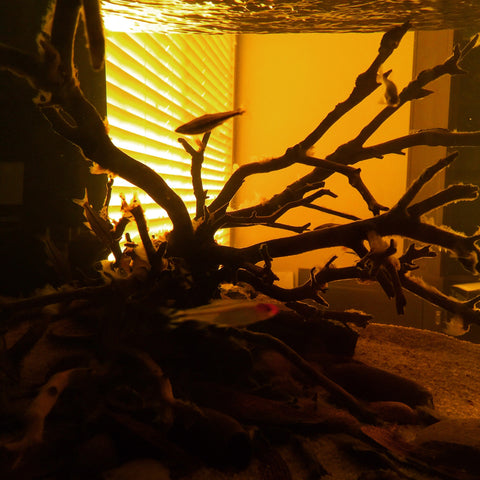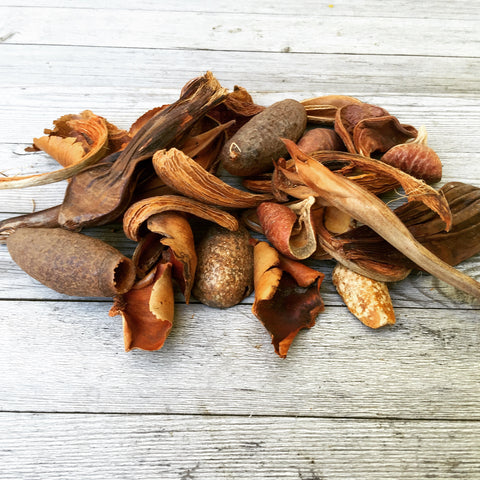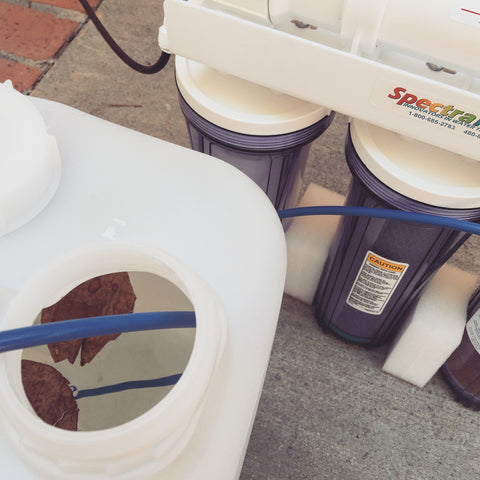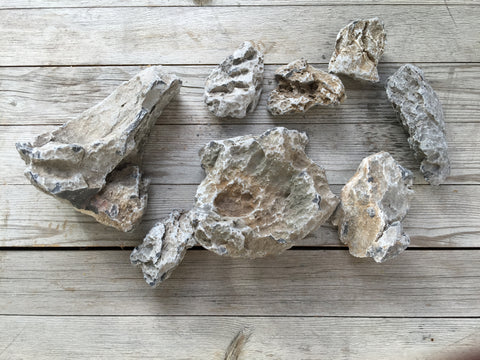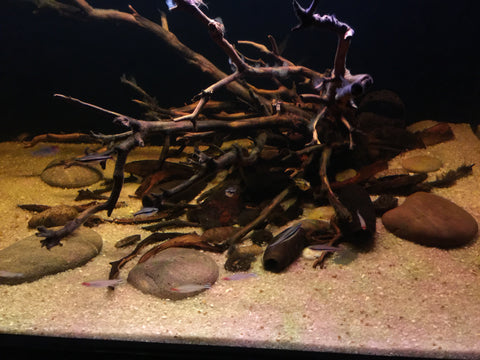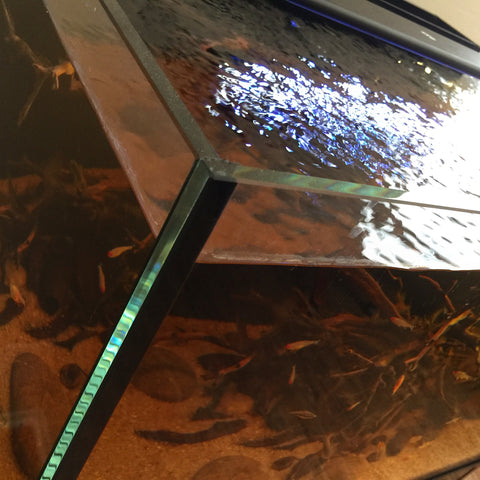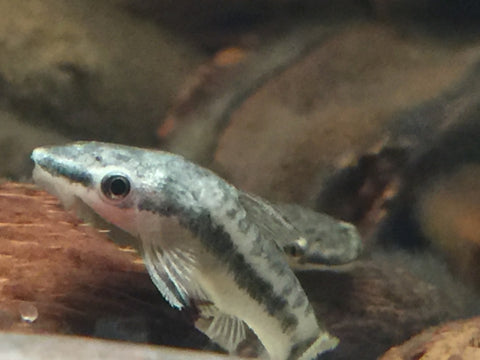- Continue Shopping
- Your Cart is Empty
Welcome to the edge...
The edge of something is kind of an uncomfortable place to be, isn't it?
"The edge of town" seems like a far-off place, without contact from the rest of society. The "cutting edge" means you're doing something that's at the current state-of-the-art, right? The "leading edge" is out in front of most everyone else, with the "safety net" to fall into should you fail being located far, far below. That's where early adapters to new ideas operate. The term "bleeding edge" is even more scary, more adventurous, defining that area where you've truly left what is known and comfortable, pushing the outside of the envelope as far as it can go..typically, to borrow the old "Star Trek" line, "Where no one has gone before."
Where do you, as an aquarist operate? Ever thought about that?
It's not too difficult now days for the typical hobbyist to work in the "cutting edge" environment, embracing hobby practices that are considered the state-of-the-art, such as breeding marine fishes, utilizing "estimative index" for fertilizing aquatic plants, or using the latest electronic controller to manage your aquarium's environment.
Where things get really interesting, however, is at the "leading edge" of the hobby. Those areas where there is no clearly defined set of instructions or rules. An area where every decision you make is a bit of an unknown quantity, with consequences to your actions that are not yet fully understood. For example, people in the marine hobby who keep non-photosynthetic coral aquariums are working the "leading edge", because many of the husbandry procedures, equipment choices, and implementations are not fully worked-out yet. There is still room to experiment, push things, and grow a bit. As early adaptors to the "New Botanical" movement, as we call it, you're at the beginning of the "leading edge" of hobby practices. Much is already known, much is yet to be learned.
Then, there is that "bleeding edge", defined as a category of ideas so new that they could have a high risk of being unreliable and lead adopters to incur greater expense and risk in order to make use of them. This area is popular among innovators, inventors, and risk takers. The first guy that took a leap of faith and mimicked natural processes by storing his Nothobranchius rachovii eggs in damp peat moss for 6 months before hatching them was seriously bleeding edge back in the day.

(Image by Cisamarc -CC BY SA 4.0)
It's not always about developing new technologies, equipment, or husbandry techniques. Sometimes, it's about ideas...creativity. Style. The risks of pushing it in those arenas are still there; only the consequences are different. Criticism and condemnation, as opposed to outright disaster. Different. Yet the same.
Where are you as an aquarist? What journeys are you willing to take to advance the state of the art in aquarium keeping? Are you adverse to risks? Are you fascinated by this nebulous, grey area where the stakes are so high and the outcomes unknown? Or, do you prefer to wait until things settle down just a bit before jumping aboard.
Does it matter? Yes. And no.
It doesn't matter where you are in the hobby. It matters where you're going.
Stay bold. Stay curious. Stay alert.
Stay Wet.
Scott Fellman
Tannin Aquatics
Is it really that hard? Is it really that costly?
Have you ever noticed that the environmental parameters that you track in your tank are typically the ones that are spot-on perfect all the time?
Yeah, I mean, it seems obvious, right? The parameters that you pay close attention to-that are typically easiest to monitor- are generally the best, most stable ones in your tank.
However, wouldn't it make more sense to figure out which parameters are the most important ones to monitor, even if they are not necessarily the least difficult or least expensive to monitor, as opposed to going nuts over the ones that we are already monitoring, which may not be as important? Perhaps redox IS important to you, even though a meter costs a lot more than any liquid reagent test kit. For that matter, maybe monitoring phosphate is important to you, even though the test is kind of a bummer to do? If it makes you a better aquarist and a more successful one, when all is said and done, wouldn't it make sense to perform the more difficult, yet more beneficial and correct one?

This logic extends to procedures, equipment choices, etc. For example, you may want to use a sponge filter in that breeding tank, but you know that you need to utilize some form of chemical filtration media- so even though it's more complex, expensive, etc., it just makes sense to go with a canister filter, right?
Need another example? If you're dealing with some delicate fish, and they need consistent, pristine water quality, the most effective way to maintain it is usually with water exchanges...Of course, water changes are not always easy, convenient, or fun for many hobbyists, despite the obvious benefits they offer.

How much better would your tank be if you could just squeak out another water change, or increase the volume of the changes you already perform? Sure, the is a trade off, in terms of time and energy expended, cost of materials, etc.- but isn't it worth it?

It's something that has a threshold that we each need to determine for ourselves.
That being said, I suggest once again that it often makes sense to be fanatical about monitoring the parameters that are important, doing the things that are necessary- not just the things that are easy or least expensive.
Something to ponder?
Stay thoughtful. Have fun. Be honest with yourself. Enjoy your fishes.
And Stay Wet
Scott Fellman
Tannin Aquatics
"Leaf it to us" to convince you to play with leaf litter...
So we talk a ton about how cool, useful, and desirable it is to have leaf litter in your aquarium, don't we?
Well, I think our enthusiasm stems from the fact that when properly and aesthetically employed, leaf litter adds a new dimension to a biotope-inspired aquarium, and adds a functionality that cannot be denied. Blackwater rivers and streams are characterized by large quantities of leaf litter and decaying botanicals on the bottom, with typically clear (but tinted) water. As discussed many times in this column, leaf litter is used as shelter, spawning ground, feeding area, and in some instances, as supplemental food itself. This is a highly productive habitat in nature that also just happens to look really cool in our aquariums, performing exactly the same function!

In wild habitats, there have been many instances where researchers have counted literally hundreds of fishes per square foot inhabiting the matrix of botanical materials on the bottom of stream beds, which consists primarily of leaf litter. As dead leaves are broken down by bacterial and fungal action, they develop biofilms and associated populations of microorganisms ("infusoria", etc.) that are an ideal food source for larval fishes. When you take into account that blackwater environments typically have relatively small populations of planktonic organisms that fish can consume, it makes sense that the productive leaf litter zones are so attractive to fishes!

Obviously, as leaves break down, the look of your aquascape will "evolve", literally "morphing" into a different scene over time. Consider leaf litter a "transitional" or "consumable" product that needs replacing over time. One of the most common questions we get is how often you need to replace your leaves. Here's my take on the subject:
You don't have to remove the decomposing leaf litter, unless you simply don't like the look. Part of the "charm", if you will, of leaf litter is that it is a surprisingly dynamic environment to watch. However, there are situations where leaving the material in could be detrimental: If it's creating unsanitary conditions, such as trapping excessive amounts of uneaten food, fish waste, etc,degrading water quality- then you'd want to a)review your husbandry practices and b)consider siphoning some of the material out. For most of us, however, I'd say to just leave the stuff in, and add new leaves as needed to maintain the "density" and aesthetic you want.

Preparation is another important part of incorporating leaf litter in your system. There are differing viewpoints on whether or not you should boil or steep the leaves. I definitely would not boil the leaves, because I feel it will remove much of the beneficial tannins and humic substances from the leaves right away. However, I take a very conservative approach in my recommendation to customers and fellow hobbyists: I say that it's never a bad idea to rinse, steep, and soak leaves before placing in your tank.

My main concern about leaves you collect yourself is contaminants, pesticides, etc., so anything you can do to eliminate them is important. They should be dried, of course, before you incorporate them. Don't skip the prep! The leaves I sell are pesticide free and free of major pollutants, yet still should be rinsed at the very least before use. I like the idea of steeping leaves in boiling water for 10-20 minutes, which helps soften them up a bit and "sterilizes" them to some extent, without "cracking off" all of the beneficial tannins bound up in their tissues.

My personal practice is much more liberal: I'll give the leaves a good rinse and typically let them soak a day or two to waterlog them before adding them into my aquariums. Really, the only reason I don't add leaves to my tanks straight away after rinsing is that, with the possible exception of "nano-sized" Catappa leaves, most of them don't sink immmediately!

So, how long do your leaves last? Well, it depends on so many factors, ranging from water chemistry to how "rough" your fishes are with them! Typically, a Catappa leaf will last a month or so before it really starts to break down. Guava, on the other hand, tends to last a much longer time in my personal experience, sometimes 2-3 months or more. Loquat lasts even longer in many cases; I've had some with me for 6 months or more! Others, like oak, beech, Magnolia, etc. are variable.

How dark will your water become as a result of adding leaves? Again, no real one answer- it's a function of many factors combined. In general, I'd suggest starting slowly, particularly if you have very soft water, which can result in significant pH dips rather rapidly when you add a large quantity of leaves at once. An important note: Leaves will not soften hard water. This is a common misnomer. Remember, just because they are staining the water with tannins doesn't necessarily mean that they are softening, or even acidifying, the water to any measurable extent.
They will possibly impact the pH in harder water, but not nearly to the extent that they will in soft water, which is devoid of most buffering capacity/mineral content. It might be argued that a "hard water/blackwater-aesthetic" style system is easier to manage (from a chemical standpoint, at least) than a soft water blackwater aquarium. I'd go so far as to say that a soft water blackwater aquarium with leaf litter and botanicals is on par with a reef aquarium, in terms of the need to manage and care for it. No more difficult than that- it just requires you to be on top of things.

The important takeaway from this brief and highly cursory discussion on leaves is that you should consider them as both a functional and aesthetic component of a well-managed biotope-inspired aquarium for many fishes. The look, the characteristics, and the utility of leaf litter makes it well-worth considering for anyone who is contemplating keeping Characins, Dwarf Cichlids, Catfishes, Barbs, Anabantoids, and many other species of fishes which hail from "blackwater" environments.
I hope you'll learn not to be afraid of the dark (water), and perhaps play around with some leaves in one of your aquariums!
Stay adventurous. Stay focused. Stay engaged.
Stay Wet.
Scott Fellman
Tannin Aquatics
Out of the aquarium, and onto the soapbox.
Before we get too far into this, I want to point out that todays piece is strictly MY OPINION. It's editorial in nature, and you may even find it offensive. For that, I actually don't apologize. I wanted to say a few things that have been on my mind of late, and some of them are highly opinionated and perhaps not pretty. I'm not trying to "pick a fight", but I am voicing a few concerns that I have about the hobby. At the very least, they are contrary to a lot of what you might read in the aquarium media, and as such, are polarizing to some.
Well, someone has to say this stuff, and it might as well be me.
Seems to me that we are in a sort of "New Golden Age" of adventure in aquariums- do you agree?

There is this new energy, interest, and excitement that is palpable. I'm not sure exactly what it is, but I can't help but think the new energy is because a lot of long-time hobbyists have started to "get off center" and try new ideas. I'd like to think that this is because we've sort of had enough of the "status quo" that, IMHO the freshwater world has been locked in for a decade or two.
Sure, there has been remarkable progression in terms of fish breeding, and some amazing planted aquarium progress, but the vast freshwater world seems to have sort of fallen into the shadows of the louder, more brash, and undeniably smaller "competitive" aquarium world and all of it's flash and bluster. Sadly, during this time, some absolutely amazing work has been done by a lot of hobbyists, particularly in the world of biotope-type aquariums.
In my opinion, much of the reason for this apparent lack of public progression overall has been because the FW world has had itself all tied up in a lot of "rules" as to just how an aquarium should look. "Competitive" aquariums have dominated the aquascaping scene for a long time now. Well-intentioned hobbyists who have stunning aquariums find themselves almost "apologizing" to...the "demigods" of the hobby because their interpretation of how an aquarium should look is not in line with that proffered by the small, yet vocal minority of people who consider themselves "keepers of the style" of various aquatic arts.
Now, let me qualify something- and it's just my opinion: I hate, hate- absolutely hate the "biotope" competitions in those planted aquarium contests. Why? Not because of the works being submitted. They're awesome. Not because of the difficulty involved in creating one. It's because the thinking is so closed minded, and the judging so rigid, that if you have the wrong twig in the tank, you're penalized and even chastised by the judges. People who have otherwise created amazing work are marginalized.
Competitions are one thing, of course, and a personal aquarium quite another. Now, I get it. They have rules that they want you to follow, and the rules create a sort of barrier to entry. Based on the strict definition that has been embraced, and the rules of the competitions, the term "biotope" seems to mean 100% faithfully accurate to the real thing, with no exceptions. That makes sense in that competitive context, but to put it in simple terms, outside of the contest world, it doesn't make sense to me to "penalize" an aquarium which has materials which represent a given environment.
Maybe we need a looser definition for the hobby in general. Perhaps, "biotope-type" or "biotope-inspired" would be best.
In my opinion, a biotope tank doesn't have to be 100% on point to be called a "biotope" aquarium. Yeah, I said it. I think that an aquarium which makes a reasonable attempt at replicating an environmental niche , while still using say, plants or other materials that might be non-specific to the biotope in question to represent those present.
Okay, I can hear you now, "Dude, really, why does it matter what we call it. A nice tank is a nice tank!"
It actually does matter because we have developed, IMHO, an overreaching "attitude" that has inhibited, and perhaps even prevented progress and inspiration, which forces progression in the hobby. Labels are not the "end all/do all" of the hobby, but in this case, they are rather important. And the double standards imposed by those who seem to have mastered the media are the problem, IMHO.

The hypocrisy, in my opinion, is obvious when we hear that term of "natural aquarium" bandied about in these contests and such, with it's trappings of strict layout guidelines, ratios, etc. That term to me is really over-used to describe many outstanding planted aquariums. As we've discussed previously, pretty much every aquarium is a "natural aquarium" in some form, as it must embrace or utilize natural processes in order to function. I think that this "label" has had an overreaching, almost nullifying affect on progress in the greater FW aquarium world, and maybe, just maybe, aquarists are starting to realize this- and even more important- starting to share the amazing work that they've been keeping to themselves for a long time.
I've seen some videos and pics of aquariums that are beautiful almost beyond description- and guess what? They don't have perfect 2:1:1 ratios of plants and wood, or rocks arranged in a perfect Asian style. They have mixed beds of substrate, algal growth, decaying leaves, tree bark, brown water, etc. In short, they look as "natural" as any "high end" competition aquarium looks, with out the sand waterfalls, sterile aesthetics, and "Lord of the Rings" fantasy elements.
They look the way waters look in nature.

And there are more and more people "coming out" with these previously unpublicized, unheralded aquariums that look amazing. To some die-hard adherents of the sterile, overly-interpretive "natural" planted tanks, they are no doubt seen as an abomination- an aesthetic disaster; or at the very least, an amusing oddity which, in their opinion, shows lack of discipline, lax husbandry, and little in the way of thought. I know this, because I've had encounters (all non confrontational, btw) with a number of these people of late, and was simply shocked at their close-minded attitudes about what constitutes a "proper" aquarium...It's scary.
But the long period of rigid group-think seems to be breaking up a bit. Look, there will always be a place for the undeniably beautiful planted aquariums that have dominated the seen for over a decade. They are awesome, and the effort, skill and discipline it takes to envision, construct, and maintain them is amazing. If the competitions want to enforce certain rules in order to enter and compete, that is fine. No denying that.
Just don't think that you can impose these standards on the whole aquascaping world anymore.
In my opinion, it's finally time to let go of rigid definitions and attitudes about what constitutes a beautiful, successful, or even "proper" aquarium in the aquarium world. We all seem to have the same goal: That is, to see out plants and animals thrive and reproduce in a stable, healthy environment. How we choose to get there is up to the individual, not to a group who holds a virtual "headlock" on "style doctrine" in the hobby. Some of the concepts and rules have brought us to this unique crossroads. Their positive influences are undeniable. However, it's time to progress, to merge thought, and to move forward. Imagine what happens when we take elements of a multitude of styles and blend them together?
Yeah.

Again, this is my opinion, my thoughts. They will not make me popular in some quarters. In fact, I'd expect to be labeled a hypocrite of sorts. I get it. But I am an open-mined one! I won't allow myself or my company to get caught up in rigid thinking or definitions of what is 'right" and "wrong" in terms of style. I know that what I like- what we present as a company- is just ONE way to go- just one idea...and it may be absurd and downright ugly to many..or exactly what others have been looking for to progress towards their goals.

There's room for all of us in this hobby world. It's a new time. A new place. A new mindset.
It's time that we all put aside our preconceptions about what constitutes a "proper" aquarium design, and embrace the uniqueness and individuality that are in every hobbyist. By not having to adhere to someone else's sense of what is "correct" and "proper", we free ourselves to progress, share, and make bold journeys to places in the hobby that have previously been the exclusive domain of imagination.
Stay adventurous. Stay open-minded. Stay free.
And stay wet.
Scott Fellman
Tannin Aquatics
The "dark side" of blackwater tanks? Only if you make it that way!
With blackwater type aquariums gaining in popularity, and the use of a wider variety of natural aquascaping materials becoming more common, we're seeing a lot more experimentation, a lot more interest, and an increase in the "body of knowledge" available to those who choose to embark on journeys towards speciality aquariums.
I think that part of the reason why blackwater tanks have been more unusual and rare in the past is because of some concerns over the management of the water quality. Yeah, that's right. We've discussed the whole "dirty" v. "clean" thing and the misconception that tannin-stained water is somehow "unclean." I think we analyzed and beat the crap out of that one.
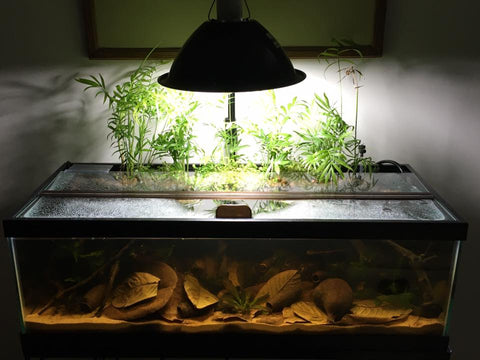
Possibly the more important issue is water parameter management as it relates to soft, acidic pH water, environmental stability, and even its implications for the ever-important nitrogen cycle. Without going into the intricate details, it's a fact that "soft" water- water with little in the way of dissolved minerals to absorb acidic compounds, is inherently a bit more prone to more rapid and significant drops in pH than "hard" water- water with greater concentration of dissolved mineral ions- and creates more challenges for the aquarist, particularly if using materials that can drop the pH of the water significantly.
TANNIN TIP: When adding botanicals to an aquarium with very soft, already acidic water, prepare all botanicals thoroughly as instructed, add them very slowly, and monitor pH /KH as you go to judge for yourself the impact of these materials on your water chemistry.
Tannins and humic acids leached into the water by botanicals, such as wood, leaves, and seed pods, can impact the pH somewhat- more significantly in aquariums with very soft water (which, as we reiterated above, are subject to a greater propensity for the ph to drop as a result), so you need to be aware of this. Remember, when you're using reverse osmosis/deionized water, it's devoid of most all minerals to help "buffer" the pH from falling towards acid, so you need to "remineralize" it with commercial additives, or utilize some buffers that typically keep the pH in the mid to high "sixes" (like 6.5-6.8). This will give you some "reserve" and stability, should the pH begin its fall towards the lower end of the pH range.
One solution towards preventing this lack of stability is to utilize some soft water with your hard water from the tap (dechlorinized, of course), to get the hardness down to a manageable and safe range of 5-10 degrees of hardness. There are formulas out there to tell you how many parts of each you need to mix to achieve a specific hardness (of course, you need to know the KH of both your tap water and RO water)- usually it works out to around 3 parts of RO to 1 part tap water, but your results will vary, so do your homework- lots of resources out there.
And of course, there are other influences on the hardness and pH of your tank water, such as the minerals contained in substrates and rocks, which can impart some buffering capacity to the water in the aquarium, potentially "neutralizing" or at least impacting the influence of the acid-producing materials on the aquatic environment.
Remember, the fact that some aquatic botanicals can release compounds capable of lowering the pH doesn't mean that, if you add them to a hard water system, with a KH of like 20 and a pH around 8.3, that you're suddenly going to achieve "Orinoco-like" conditions of soft water and low pH! Rather, with a lot of buffering capacity in the water, the impact of the botanicals on the pH will be surprisingly limited. Where you can run into trouble is in a system that already has soft, acidic water, and you add a large quantity of botanicals and wood into the system at once, particularly if they haven't been thoroughly prepared for use! The rapid release of large amounts of tannins and humic compounds can indeed drop the pH far more significantly and rapidly than you'd want, creating an extremely stressful situation for the tank's inhabitants.
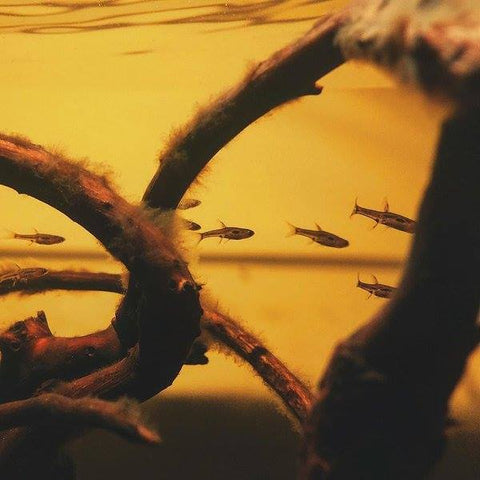
What happens when the pH plummets rapidly to levels below, say 6.0? Well, a whole lot, actually! "Acidosis" can occur in fishes, resulting in potential damage to gills, skin, and internal organs. It gets worse: In highly acid water, dentrifying bacteria (you know, the guys who help convert toxic ammonia into relatively harmless nitrate) essentially "shut down", meaning you'd be totally dependent upon materials like zeolites and other chemical absorption media to remove toxic ammonia from your aquarium water. Although achievable, this requires a LOT of monitoring and no real margin for error on your part, so the reality is, that in most circumstances, you don't want to keep your aquarium's pH below 6...or even, say, 6.5. Just too many potential issues, IMHO.
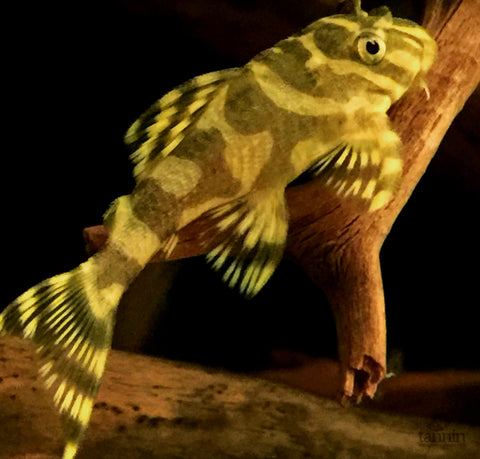
For most hobbyists with water of moderate hardness, as stated above, the impact of an influx of aquatic botanicals in an otherwise stable system will be negligible: Perhaps a slight drop in pH over time, and a definite aesthetic influence (i.e.; the color of the water!). Just because the water is "brown" is not an indication that it's soft and acidic, of course!
Like so many things in aquarium keeping, the extent to which we put our animals lives at risk is in our hands. Using aquatic botanicals to help foster "blackwater" conditions in an aquarium is no more dangerous than any other aspect of fish care. It's not all doom and gloom..You simply need to be aware of the potential of these materials to impact the aquatic environment, just like anything you add- from substrate to rocks, to driftwood-in any type of aquarium. This is no different than running an African Rift Lake cichlid tank or a reef aquarium- you need to be aware of what's going on in your water...part of the game. Blackwater aquariums, like many other "specialty" aquaria, are not "set and forget" systems. They require monitoring, management, and observation on a continuous basis.

As a responsible aquarist, you need to get in the habit of monitoring the pH and hardness of your water as a regular part of your husbandry routine. With regular monitoring, you'll be able to spot trends and see any fluctuations, etc. that can tip you off to potential problems. To embark on a "tint campaign" with aquatic botanicals in a system without having an understanding of your basic water chemistry is not only not recommended- it's downright irresponsible!
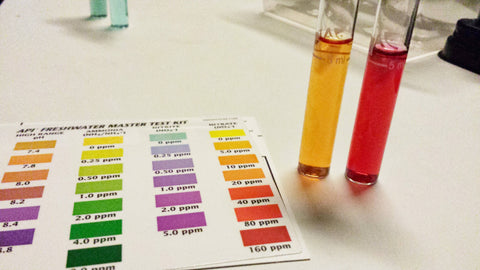
The idea of pre-conditioning your source water with materials such as Catappa leaves, etc., before it's utilized in your aquarium, makes a lot of sense. You can "mess with it" as much as you need to in remote containers to get it exactly how you want it, so you know going in exactly the conditions of the water being added to the tank. From there, you monitor the impact of your water on the existing aquarium environment. It's perhaps a slower process, but in terms of control of water parameters, is ideal.
Remember, a surprisingly large number of fish species that hail from soft water environments, such as Tetras, Apistos, Gouramis, Killies, etc, can adapt to harder, more alkaline water. Some may not look as spectacular as they do in soft, acid waters, and may not breed as easily, but the fact is that you don't have to obsess over creating these conditions in your aquarium to keep many of these fishes successfully. Many are produced commercially in conditions significantly different from those found in their will environments. Or, maybe you simply want to run a "hard-water/tinted" system, which has the aesthetics of a real blackwater environment, and far less potential issues...that's fine and a good compromise- but you still need to be aware of what's going on in your water like in any other aquarium.
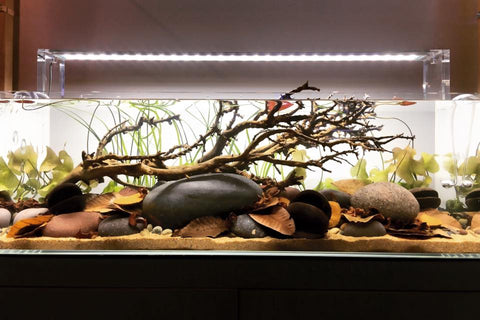
Just having stability of pH/hardness in your system, plus a little influence of the natural tannins and other compounds found in aquatic botanicals, can give your fishes some of the positive effects of blackwater environments, at least from an aesthetic standpoint, without significant risk associated with unstable water chemistry.
Regardless of how you choose to employ aquatic botanicals in your quest for a "blackwater" aquarium, it's important to take a cautious, responsible, well-informed approach, and leave nothing about you water parameters to guesswork. Knowledge is a key to success and stability in all areas of the aquarium hobby, and you should arm yourself with as much information on your aquariums as possible, for the benefit of all of the animals under your care.
Stay informed. Stay curious. Stay on top of things..
And stay wet!
Scott Fellman
Tannin Aquatics
Stuff I like....
We talk a lot about problems, how-to's, concepts, and stuff about the hobby in this column, which is a lot of fun. Ever thought about something as simple and concise as a list of stuff we like in the hobby context?
Yeah, sort of "Facebook-ized", distilled to a simple, "I like this!" It's a great exercise for us as hobbyists when we seem to think that stuff is just sort of "happening" and we're perhaps not feeling the excitement we like, or just feel like things are't really all that interesting at the moment (is there ever a time like that...um, for some...perhaps...). We get a sense of gratitude and appreciation for the hobby.
Here's a start...perhaps it will trigger some "likes" of your own:
Things I like...
*I like when I was a kid that the LFS owner would give me 8 Neon Tetras when I bought 6 of em...

* I like when you nail the temperature setting on your heater on the first try!
*I like when the package of fish stuff you ordered online comes a day earlier than expected.
*I like when the new fish that you didn't think would make it through the night is out and swimming about, eating everything in sight!
*I like when you buy aquarium plants and a little, teeny, tiny hitchhiker attached to you Rotala turns out to be an unusual Cryptocoryne!
*I like when I manage to shake off all the water from my fish net after using it without getting a drop on the floor!
* I like when I really do get an 80% plus hatch out of my "premium" brine shrimp eggs!
*I like when my friend's tank is kicking ass!

* I like when I play a hunch, make some system "tweak", and the next day, my cichlids spawn!
*I like waking up early in the morning and seeing all of my fishes still sleeping.
* I like seeing pictures of my customers' aquariums!
*I like when some tank-related task I've been dreading turns out to be super easy!
*I like seeing my fry sex out at a young age.
*I like seeing the sand rinse clear after just a few "swirls" in the bucket...
*I like when I can quickly and easily locate and stop "that" source of noise my tank has been making all day!
*I like when I find a bunch of fry swimming around in a tank where I kept that fish that has proven "impossible" for me to breed for months!

*I like when I cut the perfect length of hose for my canister filter return!
*I like when the fish I've been looking for all year shows up at my favorite source!
*I like having a dry towel handy when that "unexpected" spill occurs.
*I like a big school of Cardinal Tetras...or ANY Tetra, for that matter!
*I like catching a glimpse of my shyest fish as I pass by my tank.
*I like being able to catch that ONE evasive fish on the first try!
*I like that "glow" a tank has after you complete a water exchange.
*I like trading fish, plants, and coral frags with friends.
*I like taking a time out from whatever I'm doing and stealing a few minutes gawking at my tank!
*I like the smell of a clean aquarium.
*I like "trolling" an auction table at a fish event to see all the bags of cool fish waiting to be snapped up.
*I like getting that Anubias secured to the driftwood without typing my fingers together!
*I like when the activated carbon rinses clean and it's ready to add to the media bag.
*I like chatting my friends up about arcane fish-keeping topics...for hours!
*I like seeing a few rays of morning sunlight poking into my tank before the lights come on.
*I like finding the exact plumbing part I'm looking for at the hardware store without having to ask the salesperson for help.
*I like feeding my fishes frozen brine shrimp with a toothpick to make sure they snap up every piece.
*I like the gentle hum of a quiet water pump in action.
*I like finding the perfect piece of driftwood for that 'scape I've been thinking about.

*I like researching that weird Corydoras I've been thinking about getting.

*I like seeing an awesome example of a "common" fish and being amazed by how nice it is!
I could go on and on and on...I think you get the idea..It's a fun exercise; one which I encourage you to do once in a while, especially when you feel like you're in a "rut", or just not feeling it...
What are some things YOU like in the hobby?
Stay engaged. Stay encouraged. Stay grateful.
Stay Wet.
Scott Fellman
Tannin Aquatics
The "therapeutic value" of aquatic botanicals? Is there one?
Have you ever noticed how parts of the tropical fish industry are filled with "vagueness", and overgeneralization about the usefulness and effectiveness of various products at solving a variety of problems?
We get these kids of questions a lot; What do I mean? Well, the kinds of questions looking for those "Holy Grail" type answers, like "If I use this stuff, will it keep the water quality higher so I can do less water changes?"
Stuff like that.

Which, of course, makes me cringe...not because I know botanicals (nor any other product, really) WON'T help hobbyists accomplish that (they won't of course), but because "we" (the industry and the larger hobby culture) seem to have fostered a desire among hobbyists to find ways to skirt around science and fact and provide concise, easy, "one-stop solutions" for a variety of things that bother us.
"Can't keep fish alive? Just add some of these!" or "Overstocking your tank? Add some________ and you'll relieve some of the problems associated with this condition!"
Yikes.

Hobbyists ask us a lot if aquatic botanicals can cure or prevent various health conditions in fishes, and especially in ornamental shrimp (an area of the hobby, IMHO, that has been badly infiltrated by manufacturers selling "products" with bold claims of their very specific capabilities and limited or no science to back them up). A lot of herbs and perhaps even botanicals are positioned by the people who offer them as being somehow "therapeutic" in nature, and are offered especially to shrimp keepers as such. I think that people tend to see advertising copy with stuff like, "...for centuries, has been used in ______ as a homeopathic remedy for viruses." or whatever, and suddenly, this can be applied to fish or shrimp health issues as well...A lot of anecdotal stuff at best.

And it's made hobbyists ask questions about where our aquatic botanicals fall in all of this. DO they offer benefits that can target specific health issues?
Good questions, and quite honestly, I cannot wholeheartedly recommend any specific botanicals that will absolutely help cure specific conditions. It is known that Catappa leaves have some possible generalized anti-parasitic/antifungal capacity, because of some of the chemical precursors they contain, and there are vitamins in leaves such as Guava and Loquat, and perhaps, by extension, in some of the seed pods and such we offer. The "blacwater" conditions that they help foster are ( especially in the wild) not conducive to the growth of parasties, etc., yielding lower numbers of these types of animals in studies conducted in nature. You will often see less in the way of protozoan infections in fishes maintained in stable blackwater conditions, but that may be due to a variety of factors.

However, I am very skeptical of claims of just about any product (and honestly, in the shrimp world, you see a ton of them) that is a straight-up unprocessed botanical which claims to treat diseases and such. You see a lot of products with spectacular-sounding claims, particularly from Asia, but very little hard data to back them up. Just because a certain herb has these properties in humans and makes great tea or herbal supplement, is not indicative of its usefulness as a shrimp "health aid", IMHO. I cringe when I see that, and tend to steer clear of them. Trying to link certain benefits from the botanicals we sell to the treatment of specific conditions in shrimp (or by extension, fishes) is stretching, IMHO, and would not do you any favors.

The reality is that the botanicals we offer help foster a health environment by releasing tannins, etc. into the water, helping to create the aforementioned 'blackwater" conditions, and these waters are known for lower diversity of protozoa which might harbor pathogens. Many contain vitamins and nutrients that, while beneficial for overall shrimp and fish health, cannot themselves be specifically credited with preventing certain types of health issues.
In summary, the botanicals we offer are better suited for creating specific environmental conditions, as opposed to "curing" or "preventing" certain problems. While creating a healthy, stable environment can go a long way towards preventing some of the problems hobbyists mention, and use of botanicals can help foster these environmental conditions, I think it would be highly irresponsible of us to market them as anything other than products to use for creating interesting aesthetics and a unique type of environment.

So, I guess I haven't really given you a useful answer...and that, quite frankly, is because I cannot- and don't- in all honesty call aquatic botanicals "cures" or therapies for certain conditions. I wish I was in a better position to answer more succinctly, but I just don't think that the science is there yet for anyone to responsibly state that "X" is a good botanical to use to prevent "Y", and I'd be doing you a disservice to perpetuate anything other than the truth.
And I don't think you'd want anything less than that.
Stay informed. say curious. Stay aware.
And Stay Wet.
Scott Fellman
Tannin Aquatics
Doing the unspeakable...for you...because...I...love...you guys, really...
Wherein Scott conducts a hideous experiment to prove to everyone that you can have a fully stocked "New Botanical"-style tank without "the tint..."
Ok, I know, we've had the discussion about "tint" versus "clarity" and all...However, let's face it, one of the top questions I field here is, "Can I have lots of botanicals in my tank without brown water?"
And of course, the answer is YES!!
I hate giving "formulae" for doing stuff, but I will present a "recipe" that I used to (boo hoo) get rid of the "tint" in the water in my 50 gallon tank temporarily, just to put my money where my mouth is and show you what's possible.

First off, let me tell you, it was quite painful to conduct this experiment, as you know I'm a lover of the brown water! Nonetheless, because I love you guys, I forged ahead to see what would do the trick.
Let's cut to the chase: Without delving into every possible permutation of filter media experiments, etc. that I conducted, ere is what I arrived at:
1- Poly FIlter:

Approx. 12 oz of Sachem Matrix Carbon:

1- sachet of Sachem Purigen:

I placed these media in a media cart located in a high flow area of the filter compartment on my Innovative Marine "Fusion Lagoon 50" AIO tank. The same carts that I use for glorious, beautiful "media" like Catappa leaves, bark, and "Fundo Tropical" were utilized in this hideous experiment...Yes, something capable of creating such beauty used for such unspeakable horror.
See the results yourself after just 24 hours:
BEFORE:
AFTER:
So there you have it...you "can go home again" and have that "clear" water that some many hobbyists love, while still going all-out with aquatic botanicals. It's about husbandry, finesse...and good chemical filtration media!
Another tip- I tend to add Catappa leaves to my source water holding containers, which keeps things nicely "tinted" even before I add the water to the display. Just adding unadulterated RO water without Catappa will keep this "nice" and clear colored. (Yikes, I'm really biased).
I took the "time out from the tint" to experiment with Guava leaves, which impart far less tint on the tank, even without the chemical filtration media...As discussed in a previous blog, they are a possibility for those of you who want a slight tint but not the deep golden-brown more characteristic of Catappa...
Anyways, I'm a bit traumatized at the whole clear water thing...I'm back to tinting it up as soon as possible. Although I must admit, having "bright clear water" wit the earthy botanicals is pretty cool...
That being said, I'm thinking of setting up another tank to enjoy THAT aesthetic...This one is BROWN, baby!
Have fun. Stay true to your methods.
Stay Wet!
Scott Fellman
Tannin Aquatics
And "natural" means...what?
I was chatting with a fellow hobbyist the other day, and he was talking a lot about wanting to maintain a "natural" aquarium. Of course, the term "natural" in our hobby can mean a lot of things, and it immediately piques my interest. He then proceeded to describe the many products and pieces of equipment that he was going to employ to accomplish this, along with a rigid set of practices, procedures, layout rules, etc., and my initial, instantaneous thought was, How sad!"

Yeah, weird, huh? I mean, it seemed like he had to go through so much; follow so many "rules" just to to create a "natural" type of setup- it seemed oddly juxtaposed with the title "natural."
Of course, he started talking about the stuff we offer, and about how it was cool and all, but that we shouldn't delude ourselves into believing that our offering were useful for "natural" aquariums.
Like, huh? "Natural" What?
He proceded to tell me that including things like leaves, seed pods, etc. in a "natural" setup was "out of context" and somehow "forced"...which I thought was funny, in light of him lecturing me about the need to rigidly adhere to specific rules of layout, plant aggregations, wood orientation, etc.
Out of context with...what? Hello, brainwashing.
And worse yet, he had an "elitist" attitude that was off putting, to say the least. I mean, surprisingly nasty. As if to imply that everyone else was doing it wrong- somehow deluding ourselves into believing that we were creating ideal conditions for the aquatic life forms we keep by using other than a specific Asian "doctrine" as practiced by a small, yet vocal group of aquarists.
Yikes. I've seen this attitude before. I think it was in the reef aquarium world.
Dogma. Yuck.
Over the past decade or so, the aquarium world has embraced more natural-looking setups, which is awesome. The materials, technology, and experiences we've accumulated are impressive. We've learned so much. Yet, we seem to fall back on that most human of foibles: Attitude and arrogance. I think that we might be over-reaching when we employ the word "natural" to describe these specific types of setups. I mean, EVERY aquarium has elements that can be construed as "natural", right? I mean, every aquatic system needs to embrace the nitrogen cycle, right?

Unless someone created and threw a patent on bacteria, water, rocks, plants, etc., then all aquariums have essentially the same "essence", right? It's more about how harmoniously we combine them before we assign the moniker of "natural" to them, IMHO. Aesthetics, more so than the physical characteristics, right? Dunno. I'd like to think that the original proponents of these types of aquariums didn't have such a militant view on layout, etc., and merely were trying to impose some replicable aesthetic and husbandry "order" onto the randomness of nature, in order for us to tame it for use in aquariums, not trying to create some inflexible "doctrine."

I can't help but think that somehow, this all became somewhat "perverted" in our desire to be part of something bigger?
I mean, aquatic plants have been doing their thing for millions of years without our help. Only during the last century, since we threw 'em into a glass box called an "aquarium" has the need to come up with all of the additives, gadgetry, etc. come into play. To our benefit, in many cases, of course. However, the part that gets me- assigning a rigid definition of what it is- seems so out of context with the idea of natural harmony, IMHO.
Brilliant hobbyists are in the planted aquarium game now, to everyone's benefit. Today's planted tank are so much nicer looking than the ones I knew as a kid growing up in the hobby...And I think the better descriptor for these types of planted systems might be "nature-inspired", as that's what they are; That's what ALL aquariums are.
Inspired.

To imply that one is any more "natural" than the other because it uses $400 worth of clay substrate versus "natural" gravel versus "sand", fancy CO2 injection, etc., and then harboring an elitist attitude and enforcing a dogmatic set of rules about what is and is not "acceptable" for a "natural" aquarium seems...well, unnatural to me.
Back to me...lol 'Cause it's my blog.
At Tannin, we're not fostering rocket science here...Yup, we're just talking about providing materials made by nature to help create a certain aesthetic, which not everyone likes. I think it's a little bit of an aesthetic shift from what one typically thinks of when they talk about a "natural" aquarium these days. However, I stop way short of implying that, in order to have a truly "natural" aquarium (almost oxymoronic, now that I think about it...) a hobbyist must use seeds, pods, branches, etc.. That's absurd.
We hope that you use these materials to create displays that satisfy your craving to achieve a certain kinds of look, feel, and overall aesthetic. Please don't think for a minute that what we're espousing here is the "ultimate" way to set up an aquarium...the most "natural" way...it's just- another way. Maybe it's for you? Perhaps not. Not everyone likes the look of decomposing leaves, dark water, wood, etc.

However, if you do like the idea, we couldn't think of a more "natural" place to start...
Sorry, couldn't resist.
Only one rule here: Have fun and enjoy...and be humble. (okay, that's three, lol)
Lose the attitude. Gain the joy.
Stay humble. Stay true to YOUR dreams.
And stay wet.
Scott Fellman
Tannin Aquatics
You just can't "leaf" well enough alone, huh?
Are you into the look of leaf litter in your aquascape?
If you are, you've probably incorporated Catappa and other leaves into your 'scapes before. And perhaps, you might have considered the beautiful Guava leaf, too! A lot of our customers love the look of leaf litter, but they are a bit leery of the "tint" that Catappa leaves create, and are also concerned with the long-term viability of the leaves.

This is one of many excellent reasons to consider using Guava leaves instead. They have a few advantages over Catappa, namely, they are more "durable", lasting longer in submerged situations than Catappa, and they impart significantly less tannins into the water.

What this means to you, the aquarist, is that you can have many of the aesthetic advantages of Catappa leaves, without some of the characteristics you might find unattractive. Guava (Psidium guajava) provides many chemical benefits for aquarium use, including their well-documented antibacterial properties and their great value as a supplemental food source for ornamental shrimp.
We recommend that you steep them in boiling water for 10 minutes or so prior to use, which will help soften them and make them more palatable to shrimp, as well as to foster a "biofilm" on their surfaces, which provides supplemental grazing for shrimp and small fishes, and fry. As mentioned above, Guava leaves dissolve much more slowly than other leaves, and will last longer before requiring replacement. If you're like us, you'll leave them "in situ" until they completely break down.

So, just how much tint can one expect from Guava versus, say, Catappa leaves of similar size? There is no perfect answer, but I conducted a small and very unscientific experiment to see for myself just how much "tint" they impart.
I prepared 4 "nano"-sized Catappa leaves by steeping them for 10 minutes in boiling water, then placing them in 1 gallon of RO water. I did the same thing with 4 typical-sized Guava leaves.
After 24 hours, the "tint" of the water in the container containing the Catappa leaves was quite significant, whereas the water in the container containing the Guava leaves was much less visually affected. Regrettably, since this "experiment" was about visual impact, I failed to take a before and after pH test on each container- something I will do next time for sure.
The bottom line, as you can clearly see, is that the Guava leaves are an excellent alternative for hobbyists looking for a more modest "tint" to their water. Of course, the impact from both Catappa and Guava can be limited, or mitigated entirely with chemical filtration media, such as activated carbon, Poly Filter, Purigen, etc., along with frequent water changes with "untinted" fresh water.
 GUAVA
GUAVA
 CATAPPA
CATAPPA
As you surmise, these are ratios of leaves to water that you would not normally utilize, but I figured, for sake of this "experiment", that they would provide enough distinct visuals for you to see the difference. Next time, I'll check parameters and be a bit more "scientific" in my approach, but I'd say that this little demo did its job.
In the end, the choice is yours, and the effects can vary widely, depending upon the initial source water you start with, and a myriad of other possible factors. Regardless, it's always a good idea to go in with your eyes wide open, as the case may be, to get a good "feel" for the potential of these awesome and highly versatile aquatic botanicals.
Until next time...
Stay curious. Stay "tinted."
And Stay Wet!
Scott Fellman
Tannin Aquatics










